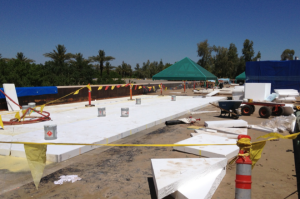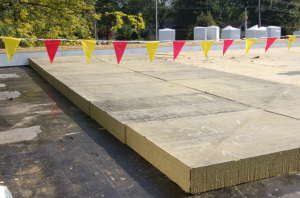INSTALLATION
Rooftop insulation should never be installed in a single layer. Let me repeat because this is important: Roof insulation should never be installed in a single layer. The insulation should be specified and installed in multiple layers with all joints offset at least 6 inches. Thermal loss through roof insulation joints can occur in association with mechanical fasteners below the membrane, resulting in an energy loss of up to 18 percent. Thermal loss may also occur because of normal dimensional changes to the board induced by temperature or humidity conditions below the roof membrane. Yes, rock stars, that means that as soon as the last roofing crews walk off the roof, the roof system is energy inefficient.
Tapered insulation is an excellent method of moving water to drainage systems. The most efficient method is what is called four-way drainage, in which the tapered insulation system emanates at the center of the roof drain with four valleys. Often, for cost considerations, a two-way slope with saddles is employed—all too often with poor results. Based on our extensive
experience, saddles must first be twice the slope of the main roof slope. Secondly, saddles need to project out from the low point a minimum of 30 percent of the distance between the roof drain center points between drains.
Let’s consider this example to determine the width of the saddles:
Distance between roof drains: 50 feet, half the distance is 25 feet multiplied by 30 percent, or 0.3 = 7.5 feet.
To reduce waste, the width should be increased to the nearest whole dimension divisible by 4. Why? Because the width of insulation boards is typically 4 feet. You’re buying the entire board; use it all!
On the roof plan, the width of the saddles should be dimensioned, indicating the distance from the roof drain to the apex of the saddle. Additionally, a pet peeve of mine is when designers show slope-direction arrows pointing to the roof drain. Note: The saddle slope is always perpendicular to the created valley.
Most insulation cannot sustain repeated foot traffic without crushing the microscopic cellular structure, which is not a desirable condition. Fully adhered systems become compromised where the wind-uplift performance is based on the ability of the roof membrane to transfer load to the insulation and down to the roof structure. Once crushed the insulation lacks this ability. On mechanically attached systems, crushed insulation near mechanical fasteners creates a point-load that often results in punctures. The preferred method to protect the insulation surface and enhance membrane adhesion is to use a coverboard. If the insulation is mechanically attached, the coverboard is set in an adhesive, which has the added benefit of minimizing the thermal short created by the screw and plate.
Thermal insulation is the best source for energy conservation and savings: It works 24 hours per day, 7 days per week, 52 weeks per year, as opposed to roof-surface color or texture. The next dollar invested in a roofing system will produce greater gains if directed into insulation rather than membrane color, especially above the Mason-Dixon line. Additionally, it is a sound base for roofing systems.
Numerous roof insulation types, facer types, application methods, and physical characteristics are available and need to be reviewed, understood and selected for the building in question so that the roof system can properly perform. Failure to perform the above-mentioned due diligence can result in a compromised roof system and possible roof system failure.
Think before design, learn before specifying and realize your decisions can have consequences.
PHOTOS: HUTCHINSON DESIGN GROUP LTD.





Be the first to comment on "Insulation Types, Application Methods and Physical Characteristics Must Be Reviewed, Understood and Selected to Ensure Roof System Performance"